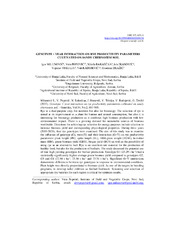Приказ основних података о документу
Genotype × year interaction on rye productivity parameters cultivated on sandy chernozem soil
Interakcija genotip × godina na parametre produktivnosti raži gajene na peskovitom černozemu
| dc.creator | Milunović, Igor | |
| dc.creator | Popović, Vera | |
| dc.creator | Rakaščan, Nikola | |
| dc.creator | Ikanović, Jela | |
| dc.creator | Trkulja, Vojislav | |
| dc.creator | Radojević, Vuk | |
| dc.creator | Dražić, Gordana | |
| dc.date.accessioned | 2022-10-05T07:17:41Z | |
| dc.date.available | 2022-10-05T07:17:41Z | |
| dc.date.issued | 2022 | |
| dc.identifier.issn | 0534-0012 | |
| dc.identifier.issn | 1820-6069 | |
| dc.identifier.uri | http://fiver.ifvcns.rs/handle/123456789/3111 | |
| dc.description.abstract | Rye is a dual-purpose crop, for nutrition but also for bioenergy. The selection of rye is aimed at its improvement as a plant for human and animal consumption, but also it is interesting for bioenergy production as it combines high biomass production with low environmental impact. There is a growing demand for sustainable sources of biomass worldwide. Directions for achieving rye selection for energy purposes include selection to increase biomass yield and corresponding physiological properties. During three years (2019-2021), four rye genotypes were examined. The aim of this study was to examine the influence of genotype (G), year (Y) and their interaction (G×Y) on rye productivity parameters: plant height (PH), spike length (SL), 1000-grain weight (TGW), hectoliter mass (HM), green biomass yield (GBY), biogas yield (BGY) as well as the possibility of using rye as an alternative fuel. Rye is an excellent raw material for the production of healthy food, but also for the production of biofuels. The study discussed the potential use of four high yielding genotypes for biofuel production. Genotype G1 (25.29 t ha-1) had a statistically significantly higher average green biomass yield compared to genotypes G2, G3 and G4 (22.98 t ha-1, 23.56 t ha-1 and 23.76 t ha-1). Significant G×Y interactions demonstrate differences between rye genotypes in response to environmental conditions. Plant height was directly proportional to biomass yield. As one of the targets in breeding programs, to develop taller cultivars as biofuel feedstock. Screening and selection of appropriate rye varieties for each region is critical for optimum results. | sr |
| dc.description.abstract | Raž je usev dvostruke namene, za ishranu i za bioenergiju. Selekcija raži ima za cilj, unapređenje biljke za ishranu ljudi i životinja, ali je interesantna i za proizvodnju bioenergije, jer kombinuje veliku proizvodnju biomase sa malim uticajem na životnu sredinu. Širom sveta postoji rastuća potražnja za održivim izvorima biomase. Pravci kojima se postiže selekcija raži u energetske svrhe obuhvata selekciju na povećanje prinosa biomase i odgovarajućih fizioloških svojstava. U trogodišnjim mikroogledima (2019-2021.) ispitivana su četiri genotipa raži. Cilj ove studije bio je da se ispita uticaj genotipa (G), godine (Y) i njihove interakcije (G×Y) na parametre produktivnosti raži: visinu biljaka (PH), dužinu klasa (SL), masu 1000 semena (TGW), hektolitarsku masu (HM), prinos zelene biomase (GBY), i prinos biogasa (BGY). Raž je odlična sirovina za proizvodnju zdravstveno bezbedne hrane ali i za proizvodnju biogoriva. Studija razmatra potencijalnu upotrebu visokoprinosnih genotipova za proizvodnju biogoriva. Genotip G1 (25.29 t ha-1) imao je statistički značajno veći prosečni prinos zelene biomase u odnosu na genotipove G2, G3 i G4 (22.98 t ha-1, 23.56 t ha-1 i 23.76 t ha-1). Interakcija G × Y pokazuje razliku između genotipova raži, kao odgovor na uslove životne sredine. Korelacija između testiranih parametara bila je značajna, ali ne posebno visoka. Visina biljaka bila je direktno proporcionalna prinosu biomase. Kao jedan od ciljeva u programima oplemenjivanja je da se kao sirovina za biogorivo stvaraju više sorte. Selekcija i odabir odgovarajućih sorti raži za svaki region je od ključnog značaja za postizanje optimalnih rezultata. | sr |
| dc.language.iso | en | sr |
| dc.publisher | Beograd : Društvo genetičara Srbije | sr |
| dc.relation | info:eu-repo/grantAgreement/MESTD/inst-2020/200032/RS// | sr |
| dc.relation | info:eu-repo/grantAgreement/MESTD/inst-2020/200116/RS// | sr |
| dc.relation | Alternative cereals and oil flax as functional foods, Provincial Secretariat for higher education and scientific research, 2021–2024 | sr |
| dc.rights | openAccess | sr |
| dc.rights.uri | https://creativecommons.org/licenses/by-nc-nd/4.0/ | |
| dc.source | Genetika-Belgrade | sr |
| dc.subject | correlations | sr |
| dc.subject | energy crops | sr |
| dc.subject | genotype by year interaction | sr |
| dc.subject | productivity parameters | sr |
| dc.subject | Secale cereale | sr |
| dc.subject | rye | sr |
| dc.subject | korelacije | sr |
| dc.subject | energetski usevi | sr |
| dc.subject | genotip x godina | sr |
| dc.subject | parametri produktivnosti | sr |
| dc.subject | raž | sr |
| dc.subject | černozem | sr |
| dc.subject | chernozem | sr |
| dc.title | Genotype × year interaction on rye productivity parameters cultivated on sandy chernozem soil | sr |
| dc.title | Interakcija genotip × godina na parametre produktivnosti raži gajene na peskovitom černozemu | sr |
| dc.type | article | sr |
| dc.rights.license | BY-NC-ND | sr |
| dc.citation.epage | 905 | |
| dc.citation.issue | 2 | |
| dc.citation.rank | M23 | |
| dc.citation.spage | 887 | |
| dc.citation.volume | 54 | |
| dc.identifier.doi | 10.2298/GENSR2202887M | |
| dc.identifier.fulltext | http://fiver.ifvcns.rs/bitstream/id/8733/bitstream_8733.pdf | |
| dc.identifier.scopus | 2-s2.0-85138171504 | |
| dc.type.version | publishedVersion | sr |


